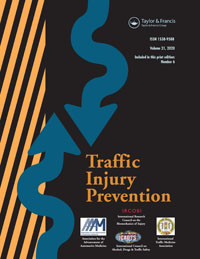
Objective: More and more pedestrians use mobile phones in their daily traffic activities by the roadside or even when crossing the street. The objective of this research is to examine pedestrians’ traffic and safety behavior while texting or web-surfing, when crossing signalized intersections. Methods: In order to compare the behavior of distracted and non-distracted pedestrians, an experimental process through video recording was carried out in real road conditions, in three signalized intersections in the center of Athens in Greece. Demographic and behavioral characteristics were observed, including use of mobile device. For the statistical analysis, two multiple linear regression models were developed to investigate the association of pedestrians’ speed and distraction caused by mobile phone use. Additionally, binary logistic regression models were developed in order to determine the influence of distraction on pedestrians’ safety characteristics and more specifically on near misses with oncoming vehicles. Results: Observers recorded crossing behaviors for 2,280 pedestrians and noticed that nearly one-fifth (16.6%) of them performed a phone-distracting activity while crossing. Distractions included texting or web-surfing (6.3%), listening to music (5.4%) and using a handheld phone (4.9%). Τhis research indicated that distraction caused by texting or web-surfing had a negative impact on pedestrians’ main traffic and safety characteristics. Results pointed out that in high pedestrian traffic, distracted pedestrians who were texting or web-surfing on their mobile phone present lower speed than non-distracted pedestrians, regardless of their age, as they may be not aware of traffic conditions due to distraction and therefore, they have higher crossing times. Furthermore, their probability of a near miss increases with increasing pedestrian volume as the more pedestrians who occupy the pedestrian crossing the more difficult is for them to observe carefully the rest traffic. Conclusions: Mobile phones are integral to contemporary daily life and their use and penetration is increasing rapidly as well. For this reason, it is crucial to investigate the impacts of distracted walking on pedestrians’ traffic and safety behavior. Various measures and strategies should be implemented and further research should be conducted as texting and web-surfing distraction is associated with a rather high risk.
| ID | pj177 |
| Manuscript | |
| DOI | |
| Tags | pedestrians, statistical modelling |







